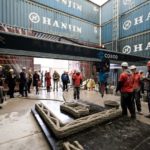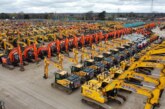The largest 3D printer in the world is about to start printing a two-storey house on the site of Kamp C, the provincial Centre for Sustainability and Innovation in Westerlo, Belgium.
Interested companies are welcome to experiment with the printer in Westerlo as of this autumn. Our endeavour is to convince the Flemish construction industry of the merits of this innovative technique with practical examples.
While 3D printing is garnering a lot of attention around the world, the first 3D printed home is still some way off. “That said, this technique is gradually gaining momentum”, says Kai van Bulck. He represents Kamp C in the C3PO-project, which was developed to introduce the Flemish construction industry to this new technology. The concrete printer that just arrived in Westerlo will play a crucial role in this. Kamp C can rely on several prominent partners for this innovative project, including Beneens, ETIB/CONCRETE HOUSE, Groep Van Roey, Thomas More, Trias architecten, Ghent University and Vicré. Saint-Gobain Weber Belgium also contributes to the project.
Trial and error
About five years ago, several Belgian universities launched their first research projects, focussing on the 3D printing of building components. Now the technique is almost ready for the next phase. Van Bulck: “We now can start to test all this theoretical know-how in practice and that is exactly what we intend to do with our 3D printer. Our main priority is to overcome all the technical challenges associated with this technique with trial and error.”
Technical questions
One such challenge is understanding which material to use. The printer that Kamp C purchased is mainly suited for printing concrete building components. “But which composition should the concrete have to ensure the printing process is as efficient as possible? This will obviously depend on the application, as we will see first-hand once we start printing”, according to Van Bulck.
In addition to this, Kamp C will also be conducting research on concrete and reinforcement. “Currently we don’t know whether we need to incorporate reinforcement in the printed components. If this proves necessary, obviously the next question will be how we can do this most efficiently and what will this mean in terms of legislation[SL1] .”
Own experiments
Kamp C has decided to start with a demo phase. All interested companies, research and education institutions are welcome to test the printer as of this autumn. These tests will also help resolve a number of technical issues.
Convincing the industry
Companies will be able to experiment with the printer until 2020, giving them plenty of time to discover all the advantages of this technique. “The concrete printer mainly offers a lot of added value for more complex building components”, says Van Bulck. “I’m thinking of vaulted ceilings or curved walls. Nowadays these components are still produced onsite. Who knows, maybe this will no longer be necessary thanks to the printer.”
According to Van Bulck, the test phase at Kamp C will be the final push that will sway the Flemish construction industry. “We expect that the construction industry will change tack as soon as we can demonstrate which components can be printed and what are the efficiency gains.”
“Kamp C wants to keep up with the latest developments and even play a pioneering role in terms of innovation in construction”, says Kathleen Helsen, the provincial deputy for European Cooperation and the President of Kamp C. “We have succeeded in this ambition with this 3D printer. This innovation offers countless new options for the entire construction industry in our province and far beyond. So it is easy to see why we chose to invest in this with the provincial executive”.
This article is part of the C3PO project. The partners received a grant of 668,320 euros from C3PO (‘Co-creation: 3D-printing with companies’), an ERDF project. The project is part of GTI Kempen (GTI stands for Gerichte Territoriale Investering, an integrated territorial investment (ITI) strategy for a specific area, combining various European funds and programmes).









